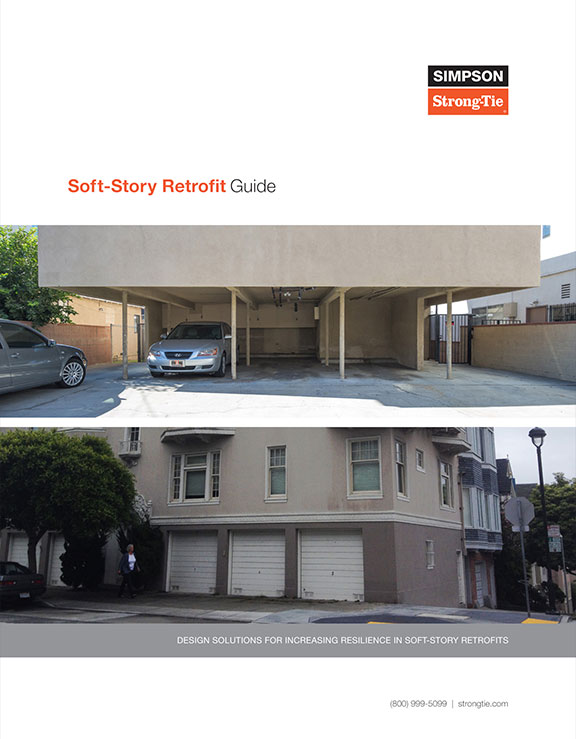

Soft-Story Retrofit for Engineers and Architects

Engineers and architects play an important role in ensuring soft-story retrofits are designed to meet various building codes and guidelines. These guidelines help assure that the soft-story retrofits can withstand a seismic event and provide a shelter in place for occupants.
San Francisco
Understanding the San Fransico Ordinance and Retrofit Solutions - The Strong Frame® special moment frame: an ideal, safe and cost-effective solution
Los Angeles
Understanding the Los Angeles Ordinance and Retrofit Solutions - The Strong Frame® special moment frame: an ideal, safe and cost-effective solution
Follow the Five Steps of the Soft-Story Retrofit
1. Designing Soft-Story Retrofits According to the Mandate
New building codes are not always suitable for existing construction. The ordinances that a number of jurisdictions are approving give design professionals several options to meet the retrofit requirements. Various building codes and guidelines, with performance objectives, are available to help guide engineers in properly retrofitting buildings. There are four codebooks, including a guideline for existing construction that can be used to retrofit unsafe structures.
- FEMA P-807 Guidelines: Seismic Evaluation and Retrofit of Multi-Unit Wood-Frame Buildings with Weak First Stories
- ASCE 41-13, Seismic Evaluation and Rehabilitation of Existing Buildings
- ASCE 41-06, Seismic Rehabilitation of Existing Buildings
- ASCE 31-03, Seismic Evaluation of Existing Buildings (Evaluation only)
- 2012 International Existing Building Code (IEBC) Appendix A4 (Retrofit only)
In addition to these established codes and guidelines, any other rational design basis that is deemed acceptable by the governing jurisdiction and that meets or exceeds the intent of the above standards might be used as well.
We developed a Soft-Story Retrofit Guide to walk you through the soft-story retrofit design considerations and requirements. The Design Guide reviews both IEBC Chapter A4 and FEMA P-807 and helps you determine which is more applicable to your soft-story retrofit project.
Retrofit City Mandate Resources
Learning Center
- Soft-Story Retrofit Online Training Course - Retrofit solutions for collapse-vulnerable multi-unit wood structures.
2. Collaborating with Other Soft-Story Retrofit Providers
As an industry, we are all striving to learn best practices from our peers. We need to ensure that providers at each step of the process understand the building codes and requirements for soft-story retrofits. It is important that we collaborate with contractors, inspectors and other parties to strengthen the resiliency of our soft-story buildings.
Cities such as San Francisco and Los Angeles have hosted earthquake fairs that bring together designers, contractors, financial institutions and other vendors to bring awareness and education regarding the soft-story mandate.
To the right are links to retrofit fairs to find professionals who undertake soft-story retrofits.
Retrofit Provider Resources
3. Selecting the Right Soft-Story Retrofit Products
Choosing soft-story retrofit products that meet code requirements and guidelines can be challenging. We have an extensive line of soft-story retrofit solutions that includes steel moment frames, shearwalls, anchors, connectors and fasteners. All of our products are code approved so you can be confident that the products used in your soft-story retrofit designs will perform optimally during an earthquake.
To view our list of soft-story retrofit products, visit our soft-story retrofit products page.
4. Choosing Soft-Story Retrofit Products Designed for Strength and Easy Installation
We design products that are easy to install but still meet stringent soft-story retrofit codes and regulations. A simple installation alleviates many construction challenges in the field, which translates into a smoother retrofit project that can be completed on-time and on-budget.
Visit our video library to view how our soft-story retrofit products are installed.
5. Working with Soft-Story Retrofit Inspection Criteria
When designing a soft-story retrofit, it is important to consider the Special Inspection Criteria to ensure that the designs meet the inspection criteria outlined by the various city building departments. Inspection plays an important role in building resiliency and in getting a retrofit process approved and completed.
The City and County of San Francisco Department of Building Inspection has issued a list of Recognized Special Inspection and Testing Agencies.
